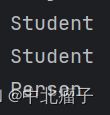Java笔记七(封装,继承与多态)
封装
该露的露,该藏的藏
程序设计追求“高内聚,低耦合”。高内聚就是类的内部数据操作细节自己完成,不允许外部干涉;低耦合:仅暴露少量的方法给外部使用
封装(数据的隐藏)
通常,应禁止直接访问一个对象中数据的实际表示,而应通过操作接口来访问
属性私有
package com.oop.demo04;
//类 private:私有
public class Student {
//属性私有
private String name; //名字
private int id; //学号
private char sex; //性别package com.oop.demo04;
public class Application {
public static void main(String[] args) {
Student s1=new Student();
s1.name//错误代码
}
}此时如果直接调用s1.name则会报错,因为属性私有
正确方法:
package com.oop.demo04;
//类 private:私有
public class Student {
//属性私有
private String name; //名字
private int id; //学号
private char sex; //性别
//提供一些可以操作这个属性的方法
//提供一些public的get.set方法
//get获得这个数据
public String getName(){
return this.name;
}
//set给这个数据设置值
public void setName(String name){
this.name=name;
}
}
package com.oop.demo04;
public class Application {
public static void main(String[] args) {
Student s1=new Student();
s1.setName("佳伟");
System.out.println(s1.getName());
}
}快捷键alt+ins快速生成get和set方法
对用户的输入进行限制,以年龄为例:
package com.oop.demo04;
//类 private:私有
public class Student {
//属性私有
private String name; //名字
private int id; //学号
private char sex;//性别
private int age;
//提供一些可以操作这个属性的方法
//提供一些public的get.set方法
//get获得这个数据
public String getName(){
return this.name;
}
public int getAge() {
return age;
}
public void setAge(int age) {//对输入不合法的年龄进行限制
if (age>120||age<0){
this.age=3;
}else {
this.age=age;
}
}
//set给这个数据设置值
public void setName(String name){
this.name=name;
}
}package com.oop.demo04;
public class Application {
public static void main(String[] args) {
Student s1=new Student();
s1.setName("佳伟");
System.out.println(s1.getName());
s1.setAge(999);
System.out.println(s1.getAge());
}
}此时年龄便会输出不合法
封装的意义:
1.提高程序的安全性,保护数据
2.隐藏代码的实现细节
3.统一接口
4.系统可维护性
继承
继承的本质是对某一批类的抽象
extends的意思是“扩展”。子类是父类的扩展
JAVA中类只有单继承,没有多继承
继承关系的俩个类,一个为子类(派生类),一个为父类(基类)。子类继承父类,使用关键字extends来表示。
假设Person是父类,Student与Teacher是子类
则可这样写
package com.oop.demo05;
public class Person {
}package com.oop.demo05;
public class Student extends Person {
}package com.oop.demo05;
public class Teacher extends Person {
}子类继承父类,就会拥有父类的全部方法
package com.oop.demo05;
public class Person {
public void say(){
System.out.println("说了一句话");
}
}package com.oop.demo05;
public class Application {
public static void main(String[] args) {
Student student=new Student();
student.say();
}
}但是拥有父类的所有方法不代表可以使用父类的所有方法,例如使用封装的关键词private
package com.oop.demo05;
public class Person {
private int money=10_0000_0000;
public void say() {
System.out.println("说了一句话");
}
public int getMoney(){
return money;
}
public void setMoney(int money){
this.money=money;
}
}则子类需使用父类设置的方法使用
package com.oop.demo05;
public class Application {
public static void main(String[] args) {
Student student=new Student();
student.say();
System.out.println(student.getMoney());
}
}IDEA快捷键:
ctrl+H:查看程序树
super
调用父类,如下
package com.oop.demo05;
public class Student extends Person {
private String name="jiawei";
public void print(){
System.out.println("Student");
}
public void test(String name){
System.out.println(name);
System.out.println(this.name);
System.out.println(super.name);//调用父类
}
}package com.oop.demo05;
public class Person {
protected String name="weiwei";
public void print(){
System.out.println("Person");
}
}package com.oop.demo05;
import com.oop.demo05.Person;
import com.oop.demo05.Student;
public class Application {
public static void main(String[] args) {
Student student=new Student();
student.test("佳伟");
}
}运行结果如下
调用父类方法:
package com.oop.demo05;
public class Person {
protected String name="weiwei";
public void print(){
System.out.println("Person");
}
}package com.oop.demo05;
public class Student extends Person {
private String name="jiawei";
public void print(){
System.out.println("Student");
}
public void test1(){
print();//当前类
this.print();//当前类
super.print();//调用父类
}
public void test(String name){
System.out.println(name);
System.out.println(this.name);
System.out.println(super.name);//调用父类
}
}
package com.oop.demo05;
import com.oop.demo05.Person;
import com.oop.demo05.Student;
public class Application {
public static void main(String[] args) {
Student student=new Student();
//student.test("佳伟");
student.test1();
}
}运行结果如下
私有的东西同样无法被继承
注意调用父类的构造器必须放在子类构造器的第一行
super注意点
1.super调用父类的构造方法,必须在构造方法的第一个
2.super必须只能出现在子类的方 法或者构造方法中
3.super和this不能同时调用构造方法
与this对比
代表的对象不同
this:本身调用者这个对象
super:代表父类对象的应用
前提
this:没有继承也可以使用
super:只能在继承条件才可以使用
this():本类的构造
super():父类的构造
方法的重写
静态方法:
package com.oop.demo05;
public class A extends B{
public static void test() {
System.out.println("A=>test()");
}
}package com.oop.demo05;
public class A extends B{
public static void test() {
System.out.println("A=>test()");
}
}package com.oop.demo05;
import com.oop.demo05.A;
import com.oop.demo05.B;
public class Application {
public static void main(String[] args) {
//方法的调用只和左边,定义的数据类型有关
A a=new A();
a.test();
//父类的引用指向了子类
B b=new A();
b.test();
}
}运行结果如下:
可以发现方法的调用只和左边,定义的数据类型有关
非静态方法的重写:
A与B同时去掉static
package com.oop.demo05;
public class B {
public void test() {
System.out.println("B=>test()");
}
}package com.oop.demo05;
public class A extends B{
public void test() {
System.out.println("A=>test()");
}
}
package com.oop.demo05;
import com.oop.demo05.A;
import com.oop.demo05.B;
public class Application {
public static void main(String[] args) {
//方法的调用只和左边,定义的数据类型有关
A a=new A();
a.test();
//父类的引用指向了子类
B b=new A();//子类重写了父类的方法
b.test();
}
}运行结果如下
alt+ins快捷键:快速重写方法
静态的方法与非静态的方法区别很大
此时子类才重写了父类的方法,才算重写
重写的关键词只能是public
重写:需要有继承关系,子类重写父类的方法!
1.方法名必须相同
2.参数列表必须相同
3.修饰符:范围可以扩大:public>Protected>Default>private
4.抛出的异常:范围,可以被缩小,但不能扩大:ClassNotFoundException——>Exception(大)
重写,子类的方法和父类必要一致;方法体不同!
为什么需要重写:
父类的功能,子类不一定需要或者不一定满足
多态
package com.oop.demo06;
public class Application {
public static void main(String[] args) {
//一个对象的实际类型是确定的
//new Student();
//new Person();
//可以指向的引用类型就不确定了
//Student能调用的方法都是自己的或者继承父类的
Student s1=new Student();
//Person父类型,可以指向子类,但是不难调用子类独有的方法
Person s2=new Student();//父类的引用指向子类
//对象能执行哪些方法,主要看对象左边的类型,和右边关系不大
s2.run();//子类重写了父类的方法,执行子类的方法
s1.eat();
}
}.
package com.oop.demo06;
public class Student extends Person {
@Override
public void run() {
System.out.println("son");
}
public void eat(){
System.out.println("eat");
}
}package com.oop.demo06;
public class Person {
public void run(){
System.out.println("run");
}
}子类能调用的方法都是自己的或者继承父类的
父类型可以指向子类,但是不能调用子类独有的方法
可以强制类型转换把s2从父类转换成子类
((Student)s2).eat();
多态注意事项:
1.多态是方法的多态,属性没有多态
2.父类和子类有联系 否则有类型转换异常 ClassCastException
2.存在条件:继承关系,方法需要重写,父类引用指向子类对象
不能重写的关键词:
1.static 方法,属于类,它不属于实例
2.final 常量
2.private方法






